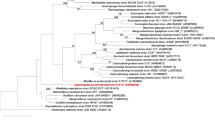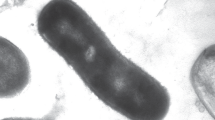Abstract
From anaerobic enrichments with 2,3-butanediol as sole substrate pure cultures of new Gram-negative, strictly anaerobic, non-sporeforming bacteria were isolated. Similar isolates were obtained with acetoin as substrate. From marine muds in saltwater medium a short rod (strain Gra Bd 1) was isolated which fermented butanediol, acetoin and ethylene glycol to acetate and ethanol. The DNA base ratio of this strain was 52.3 mol% guanine plus cytosine.
From freshwater sediments and sewage sludge, a different type of short rod (strain Ott Bd 1) was isolated in freshwater medium, which fermented butanediol, acetoin, ethanol, lactate and pyruvate stoichiometrically to acetate and propionate. Propanol and butanol were oxidized to the respective fatty acids with concomitant reduction of acetate and bicarbonate to propionate. The DNA base ratio of strain Ott Bd 1 was 57.4 mol% guanine plus cytosine. No other substrates were used by the isolates, and no other products could be detected. In cocultures with Acetobacterium woodii or Methanospirillum hungatei, strain Gra Bd 1 also grew on ethanol, propanol, and butanol by fermenting these alcohols to the respective fatty acids and molecular hydrogen. Cytochromes could not be detected in any of the new isolates. Since both types of bacteria can not be affiliated to any of the existing genera and species, the new species Pelobacter carbinolicus and Pelobacter propionicus are proposed. The mechanism of butanediol degradation and propionate formation from acetate as well as the ecological importance of both processes are discussed.
Similar content being viewed by others
References
Adams GA, Stainer RY (1945) Production and properties of 2,3-butanediol. III. Studies on the biochemistry of carbohydrate fermentation by Aerobacillus polymyxa. Can J Res 23b:1–9
American Public Health Association Inc, ed (1969) Standard methods for the examination of water and wastewater including bottom sediments and sludge. New York, pp 604–609
Barker HA (1937) The production of caproic and butyric acids by the methane fermentation of ethyl alcohol. Arch Mikrobiol 8:416–421
Barker HA (172) Corrinoid-dependent enzymic reactions. Ann Rev Biochem 41:55–90
Barker HA, Haas V (1944) Butyribacterium, a new genus of Gram-positive, non-sporulating anaerobic bacteria of intestinal origin. J Bacteriol 47:301–305
Beisenherz G, Bolze HJ, Bücher T, Czok R, Garbade KH, Meyer-Arendt E, Pfleiderer G (1953) Diphosphofructose-Aldolase, Phosphoglyceraldehyd-Dehydrogenase, Milchsäure-Dehydrogenase, Glycerophosphat-Dehydrogenase und Pyruvat-Kinase aus Kaninchenmuskulatur in einem Arbeitsgang. Z Naturforsch 8B:555–577
Bergmeyer HU (1974) Methoden der enzymatischen Analyse, 3rd ed. Verlag Chemie, Weinheim
Bornstein BT, Barker HA (1948a) The nutrition of Clostridium kluyveri. J Bacteriol 55:223–230
Bornstein BT, Barker HA (1948b) The energy metabolism of Clostridium kluyveri and the synthesis of fatty acids. J Biol Chem 172:659–669
Bryant MP, Wolin EA, Wolin MJ, Wolfe RS (1967) Methanobacillus omelianskii, a symbiotic association of two species of bacteria. Arch Mikrobiol 59:20–31
Buchanan RE, Gibbons NE (1974) Bergey's manual of determinative bacteriology, 8th ed. Williams and Wilkins Co, Baltimore
Cline JD (1969) Spectrophotometric determination of hydrogen sulfide in natural waters. Limnol Oceanogr 14:454–458
De Ley J (1970) Reexamination of the association between melting point, buoyant density and the chemical base composition of deoxyribonucleic acid. J Bacteriol 101:738–754
Gaston LW, Stadtman ER (1963) Fermentation of ethylene glycol by Clostridium glycolicum sp. n. J Bacteriol 85:356–362
Goldberg J, Cooney CL (1981) Formation of short-chain fatty acids from H2 and CO2 by a mixed culture of bacteria. Appl Environ Microbiol 41:148–154
Höhn-Bentz H, Radler F (1978) Bacterial 2,3-butanediol dehydrogenases. Arch Microbiol 116:197–203
Jay JM (1982) Antimicrobial properties of diacetyl. Appl Environ Microbiol 44:525–532
Kingsley VV, Hoeninger J (1973) Growth, structure and classification of Selenomonas. Bacteriol Rev 37:479–521
Kosikowski FV (1979) Whey utilization and whey products. J Dairy Sci 62:1149–1160
Laanbroek HJ, Abee T, Voogd JL (1982) Alcohol conversions by Desulfobulbus propionicus Lindhorst in the presence and absence of sulfate and hydrogen. Arch Microbiol 133:178–184
Ledingham GA, Adams GA, Stanier RY (1945) Production and properties of 2.3-butanediol. I. Fermentation of wheat mashes by Aerobacillus polymyxa. Can J Res 23F:48–71
Long SK, Patrick R (1963) The present status of the 2.3-butylene glycol fermentation. Adv Appl Microbiol 5:135–155
Magee CM, Rodeheaver G, Edgerton MT, Edlich RF (1975) A more reliable Gram staining technic for diagnosis of surgical infections. American J Surgery 130:341–346
Marmur J (1961) A procedure for the isolation of deoxyribonucleic acid from microorganisms. J Mol Biol 3:208–218
Palsson BO, Fathi-Afshar S, Rudd DF, Lightfood EN (1981) Biomass as a source of chemical feedstocks: an economic evaluation. Science 213:513–517
Pfennig N (1978) Rhodocyclus purpureus gen. nov. and sp. nov., a ring-shaped, vitamin B12-requiring member of the family Rhodospirillaceae. Int J Syst Bacteriol 23:283–288
Rose JA, Grunberg-Manago M, Korey SR, Achoa S (1954) Enzymatic phosphorylation of acetate. J Biol Chem 211:737–756
Samain E, Albaniac G, Dubourgier HC, Touzel JP (1982) Characterization of a new propionic acid bacterium that ferments ethanol and displays a growth factor dependent association with a Gram negative homoacetogen. FEMS Microbiol Lett 15:69–74
Schink B (1984) Clostridium magnum sp. nov., a non-autotrophic homoacetogenic bacterium. Arch Microbiol (submitted)
Schink B, Pfennig N (1982a) fermentation of trihydroxybenzenes by Pelobacter acidigallici gen. nov. sp. nov., a new strictly anaerobic, non-sporeforming bacterium. Arch Microbiol 133:195–201
Schink B, Pfennig N (1982b) Propionigenium modestum gen. nov. sp. nov., a new strictly anaerobic, nonsporing bacterium growing on succinate. Arch Microbiol 133:209–216
Schink B, Schlegel HG (1979) The membrane-bound hydrogenase of Alcaligenes eutrophus. I. Solubilization, purification, and biochemical properties. Biochim Biophys Acta 567:315–324
Schink B, Stieb M (1983) Fermentative degradation of polyethylene glycol by a new, strictly anaerobic, Gram negative, nonsporeforming bacterium, Pelobacter venetianus sp. nov. Appl Environ Microbiol 45:1905–1913
Schink B, Thompson TE, Zeikus JG (1982) Characterization of Propionispira arboris gen. nov. sp. nov., a nitrogen-fixing anaerobe common to wetwoods of living trees. J Gen Microbiol 128:2771–2779
Schlegel HG, Vollbrecht D (1980) Formation of the dehydrogenases for lactate, ethanol and butanediol in the strictly aerobic bacterium Alcaligenes eutrophus. J Gen Microbiol 117:475–481
Speckmann RA, Collins EB (1968) Diacetyl biosynthesis in Streptocuccus diacetilactis and Leuconostoc citrovorum. J Bacteriol 951:174–180
Speckmann RA, Collins EB (1982) Microbial production of 2.3-butylene glycol from cheese whey. Appl Environ Microbiol 43:1216–1218
Stadtman ER (1955) Phosphotransacetylase from Clostridium kluyveri. In: Colowick SP, Kaplan NO (eds) Methods in enzymology, vol 1. Academic Press, New York, pp 596–599
Stouthamer AG (1979) The search for correlation between theoretical and experimental growth yields. In: Quayle JR (ed) International review of biochemistry, microbial biochemistry, vol 21. University Park Press, Baltimore, pp 1–47
Taylor MB, Juni E (1960) Stereoisomeric specificities of 2,3-butanediol dehydrogenases. Biochim Biophys Acta 39:448–457
Thauer RK, Jungermann K, Decker K (1977) Energy conservation in chemotrophic anaerobic bacteria. Bacteriol Rev 41:100–180
Toraya T, Honda S, Fukui S (1979) Fermentation of 1,2-propanediol and 1,2-ethanediol by some genera of Enterobacteriaceae, involving coenzyme B12-dependent diol dehydratase. J Bacteriol 139:39–47
Widdel F, Pfennig N (1981) Studies on dissimilatory sulfate-reducing bacteria that decompose fatty acids. I. Isolation of new sulfate-reducing bacteria enriched with acetate from saline environments. Description of Desulfobacter postgatei gen. nov. sp. nov. Arch Microbiol 129:395–400
Widdel F, Pfennig N (1982) Studies on dissimilatory sulfate-reducing bacteria that decompose fatty acids. II. Incomplete oxidation of propionate by Desulfobulbus propionicus gen. nov. sp. nov. Arch Microbiol 131:360–365
Zeikus JG, Lynd LH, Thompson TE, Krzycki JA, Weimer PJ, Hegge PW (1980) Isolation and characterization of a new, methylotrophic, acidogenic anaerobe, the Marburg strain. Curr Microbiol 3:381–386
Author information
Authors and Affiliations
Rights and permissions
About this article
Cite this article
Schink, B. Fermentation of 2,3-butanediol by Pelobacter carbinolicus sp. nov. and Pelobacter propionicus sp. nov., and evidence for propionate formation from C2 compounds. Arch. Microbiol. 137, 33–41 (1984). https://doi.org/10.1007/BF00425804
Received:
Accepted:
Issue Date:
DOI: https://doi.org/10.1007/BF00425804




